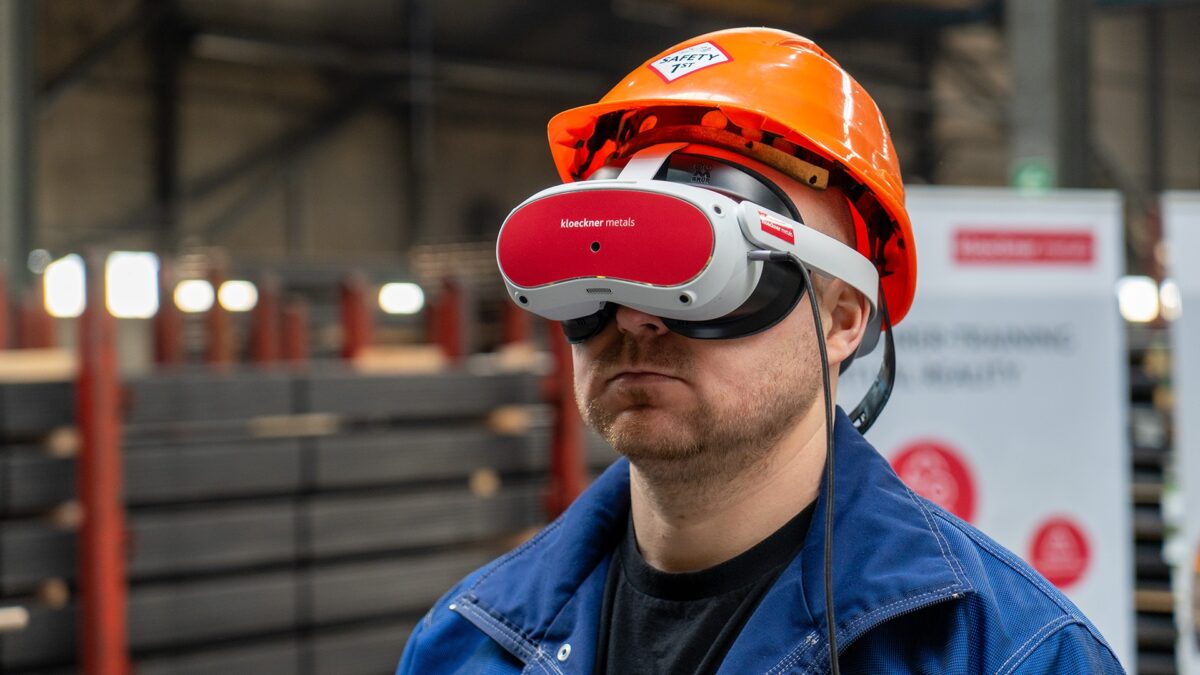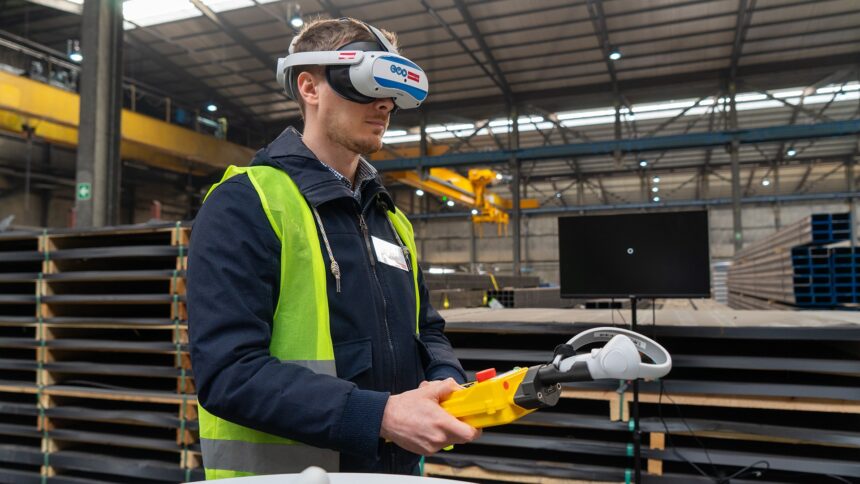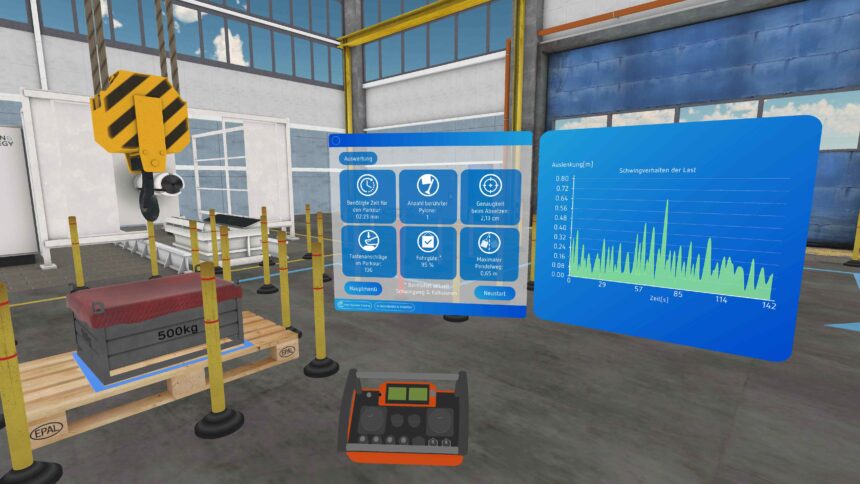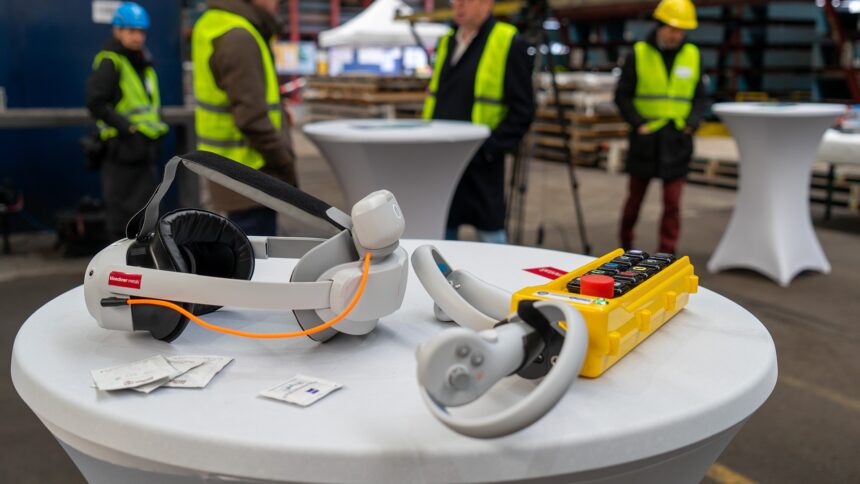Crane training in Virtual Reality: The fun is just a side effect - Report

Kloeckner Metals Germany now trains crane operators in a VR environment. One of Germany's largest steel traders is pleased with the increased safety for its employees as well as greater efficiency in training. Our guest author found out during the first presentation that the whole thing is even a bit of fun.
Like everyone else, Felix Schmitz wears a yellow plastic helmet. Together with his employees and the invited press, the CEO of Kloeckner Metals Germany GmbH, watches a worker whose face is covered by a VR headset.
The worker holds a plastic box, the remote control for a giant crane. Although it is virtual, as is the load hanging from his steel cable, the experienced crane operator feels no difference from reality. He demonstrates to the invited guests how Kloeckner Metals Germany intends to train its employees from now on. "A German-wide premiere in the steel industry", emphasizes CEO Schmitz.
Training in VR but with real remote control
Later, I get to try out the VR-based training environment for crane operators, which Kloeckner claims is unique in the German steel industry. I put on the VR headset, a Pico 4 Enterprise, and immediately notice that the field of vision is wide, the image is sharp, and the headset is light and easy to handle. Instead of the usual VR controllers, I hold a real crane remote control in my hands.
Using passthrough, a live image of the real crane remote control is played into my virtual world. I can see it and my fingers on it at all times — as the only object from the real world around me. To enable the Pico to track the crane remote control, the developers have attached a controller to it.

During the training in VR, the participants use a real crane remote control. | Picture: Jörn Schumacher
This offers huge advantages: Users don't have to fiddle with a virtual representation of the controls in a vacuum, but operate the actual device. The remote control is even interchangeable, say the developers from "Motions & Strategy" in Aachen, who implemented the project for Kloeckner. To ensure that pressing the buttons on this "dummy" transmits the corresponding movements to the virtual crane, specially built circuit boards pick up the electronic commands in the device. The system can handle different remote controls.
Some still require a cable connection, others transmit the commands wirelessly via Bluetooth. You could actually control a real crane remotely using VR headsets, couldn't you? The developers dismiss the idea, saying that they are not currently working on it and that it doesn't really make sense, as you would then have to constantly monitor the behavior of the real crane with numerous sensors. "But of course, in a remote scenario, you could operate such a huge crane from a remote office," say the developers.
Kloeckner Metal boss: "You can't be successful without innovation!"
In the virtual world, I am standing in a replica of the industrial hall as it actually stands at the Nuremberg site. It was realized with Unity. Even though there are no superfluous bells and whistles here, everything looks very lifelike. Partly because I'm holding a real control box in my hands, my brain is very quickly convinced that the virtual world is the new "real" environment. Movement takes place by means of teleportation to avoid motion sickness.
Sometimes I need to interact with the people around me. All it takes is a click on the appropriate avatar. For example, I may need to tell them that they are standing in a danger zone or in the way and should move. My first task is to lift a pallet of boxes. When I have successfully maneuvered it through a black ring, a small bell rings — well done! A friendly voice tells me exactly what to do.
It's easy and even a bit fun. Because I can move loads that seem to weigh tons back and forth without endangering anyone or damaging anything. I quickly realize that it's not so easy to navigate precisely with a steel spool weighing several tons swinging in front of me. An experienced crane operator gives me a tip: just lift the load up and shorten the steel cable holding it, and the swinging movement will become weaker. Logical, really.

The crane training is carried out in a complete VR environment. | Picture: Jörn Schumacher
Kloeckner Metals Germany is one of the largest materials distributors in Germany. Founded in Duisburg in 1906, the company has 15 locations in Germany with about 800 employees. Its turnover is 1.1 billion euros. The parent company Kloeckner & Co acts as a link between steel production and consumption, with 160 locations in 13 countries and 7,800 employees. Turnover: 9.4 billion euros.
Every day, the gantry cranes move up to 600 tons of steel from A to B, says Fred Holzer, branch manager in Nuremberg. The steel can be pipes, sheet metal or 12-meter-long steel girders. There are three high-bay warehouses in the Nuremberg plant alone, and 17 of the big yellow gantry cranes that I know from the VR training environment are scattered throughout the huge hall. I'm fascinated by the thought that if I can master the virtual crane, I could theoretically operate one of these monsters.
"We are pioneers in the digital transformation of the steel industry," emphasizes Kloeckner-CEO Schmitz. According to Schmitz, the industry is currently facing major challenges. "Anyone who reads the newspapers knows that." Only those who are innovative can remain successful. "The introduction of the VR application is another step forward. Virtual Reality is more than just a game console," emphasizes Schmitz. "The value of VR for German industry is enormous. There is still a lot of potential for the future."
TÜV Süd has long been on board
Ten practical exercises are carried out in the Crane VR environment — and they comply with guideline No. 2194 of the Association of German Engineers (VDI). Situations can be simulated that would be difficult to realize in real life, such as a person walking into the danger zone, coming into contact with a heavy load, or even being injured by it. The software can also evaluate behavior on the equipment at the end of a session and illustrate individual learning curves: How much time did I take, how many collisions did I have, how accurately did I set down my loads, how much swing was there, how often did I have to readjust, were there any collisions?
Of course, an official practical test is still required. However, the German professional association for wood and metal (BGHM) already recognizes the practical part of the crane operator training with the VR crane application, Kloeckner Metals announced. "In the near future, this will also be integrated into the crane operator examination."

A VR controller has been attached to the VR headset so that it recognizes the real remote control. | Picture: Jörn Schumacher
Motions & Strategy, a developer based in Aachen, Germany, has five employees and specializes in VR applications for industry. The company developed its first VR application in 2016, when VR was still quite exotic, says project manager Christoph Vanwersch. "In studies, test subjects were able to concentrate much better in a VR environment than in an augmented reality application," says the communication design graduate. "In VR, the user is even more immersed in the virtual environment, and there are no colleagues from the real world to distract you."
TÜV Süd has long recognized the industry's great interest in VR and has set up its own platform for training environments. Existing applications can be presented to other customers via this platform. In addition to VR applications, the VR academy called "Immersive Virtual Expert Experience" (IVEE), which was launched in 2019, also offers 360-degree video tours and "serious games" as desktop applications.
There are now 22 applications, for example for logistics or the high-voltage sector, according to Sebastian Henrich from the TÜV Academy, who was also present at the presentation of the new VR crane system. TÜV Süd has been working closely with the developers of "Motions & Strategy" for several years. The new crane VR application for Kloeckner Metals is already available on the platform. Christoph Vanwersch of Motions & Strategy says: "The first VR crane application has laid the foundation for a new sector of industrial applications. In the future, other companies could use a similar system and then purchase their own modular system."
Note: Links to online stores in articles can be so-called affiliate links. If you buy through this link, MIXED receives a commission from the provider. For you the price does not change.